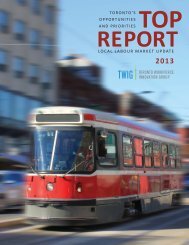challenges facing express delivery services in canada's urban centres
challenges facing express delivery services in canada's urban centres
challenges facing express delivery services in canada's urban centres
Create successful ePaper yourself
Turn your PDF publications into a flip-book with our unique Google optimized e-Paper software.
Institute of Hous<strong>in</strong>g & Mobility<br />
Challenges <strong>fac<strong>in</strong>g</strong> the EDS <strong>in</strong>dustry <strong>in</strong> Canada's <strong>urban</strong> <strong>centres</strong><br />
REVIEW OF URBAN TRANSPORT PLANS<br />
While transport planners <strong>in</strong> <strong>urban</strong> areas are responsible for all issues related to transport, it often<br />
turns out that the planners are more concerned about passenger transportation. The attention<br />
paid to freight transport <strong>in</strong> general and the couriers <strong>in</strong>dustry <strong>in</strong> particular is m<strong>in</strong>imal.<br />
In order to ga<strong>in</strong> firsthand knowledge of plann<strong>in</strong>g <strong>in</strong>itiatives related to commercial transportation,<br />
we designed and adm<strong>in</strong>istered a survey of transport planners <strong>in</strong> large <strong>urban</strong> <strong>centres</strong> (population<br />
greater than 0.5 million) <strong>in</strong> Canada. A copy of the survey form is located <strong>in</strong> the appendix.<br />
Despite our best efforts, the response from <strong>urban</strong> transport planners, employed by municipal<br />
governments, was very poor. After months of lobby<strong>in</strong>g, the project team was unable to get even<br />
a s<strong>in</strong>gle transport planner to participate <strong>in</strong> the survey. In fact, some planners were of the view<br />
that plann<strong>in</strong>g of commercial vehicles, especially couriers and same-day messengers, was not even<br />
a transportation issue and therefore not part of the transport plann<strong>in</strong>g mandate. Consider an<br />
email response received from the transport plann<strong>in</strong>g department <strong>in</strong> one of the cities contacted <strong>in</strong><br />
Canada that reflects the lack of awareness amongst municipal transport planners about freight<br />
and couriers.<br />
FIGURE 8: TRANSPORT PLANNERS CONSIDER COURIERS OUT OF THEIR PLANNING MANDATE<br />
The lacklustre response by <strong>urban</strong> planners required us to adopt an alternative approach. The<br />
project team decided to review the latest municipal transport plans for large <strong>urban</strong> <strong>centres</strong> <strong>in</strong><br />
Canada to determ<strong>in</strong>e if commercial vehicle plann<strong>in</strong>g is addressed.<br />
Needless to say, the needs of the courier and light goods transportation <strong>in</strong>dustry need to be<br />
accounted for to ensure that Canadian <strong>in</strong>dustries are able to conduct bus<strong>in</strong>ess and operate<br />
efficiently. The po<strong>in</strong>ts-of-contact between couriers and customers, the pick-ups and deliveries at<br />
local addresses, are by their very nature transitory and dispersed. As such, the level of<br />
government with the greatest <strong>in</strong>fluence on courier operations is the local, municipal level. In this<br />
section the transport plans <strong>in</strong> Canada’s largest city-regions of Toronto, Montreal, Vancouver,<br />
Ottawa, Calgary, Edmonton, W<strong>in</strong>nipeg, and Hamilton are reviewed.<br />
Page 17
















![Creative City Planning Framework [PDF] - City of Toronto](https://img.yumpu.com/24270607/1/190x245/creative-city-planning-framework-pdf-city-of-toronto.jpg?quality=85)